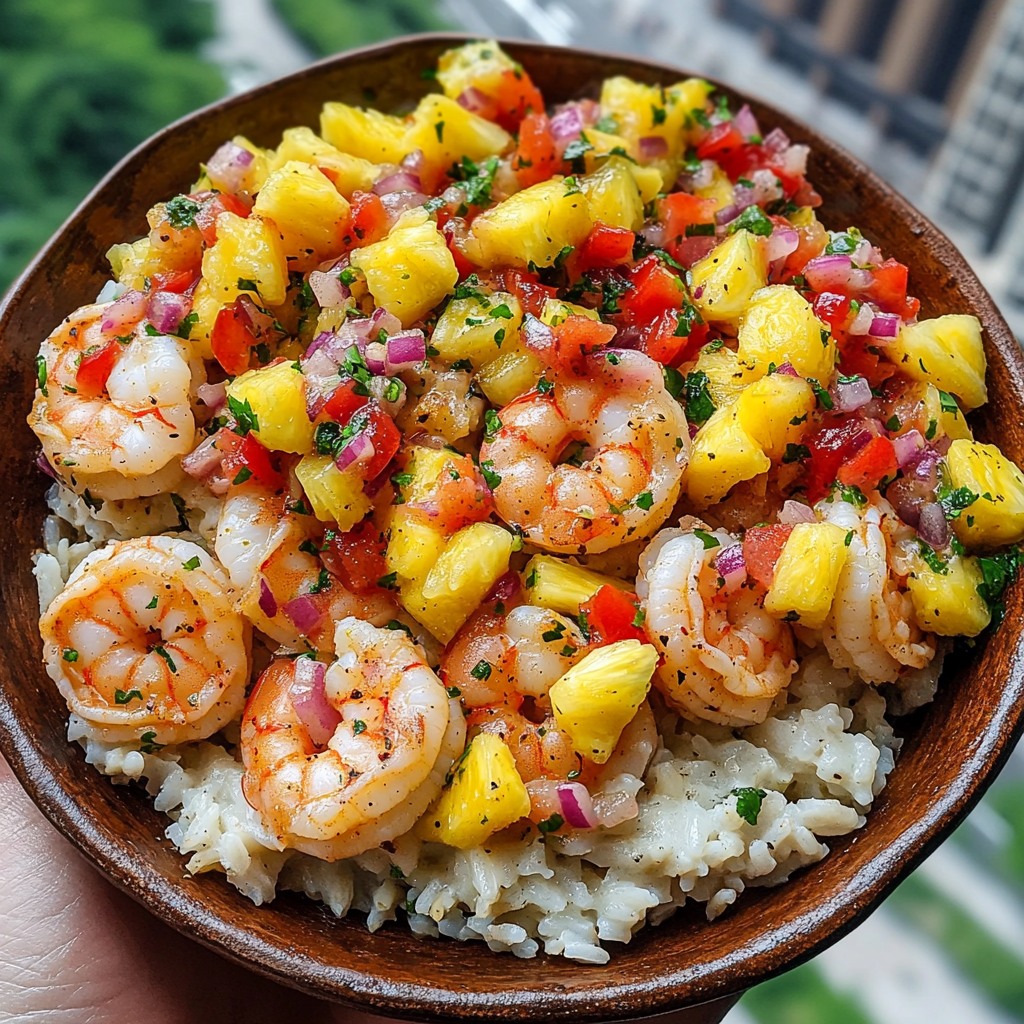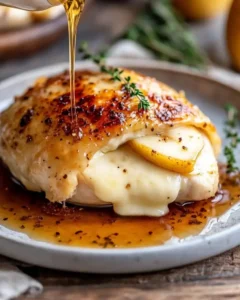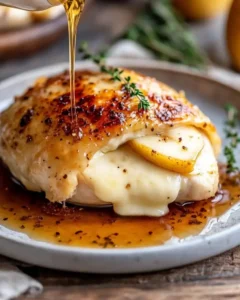Tropical Shrimp and Rice Delight: A Culinary Adventure with Fresh Pineapple Salsa
Experience an explosion of flavors with this Tropical Shrimp and Rice Delight, perfectly paired with a Fresh Pineapple Salsa that highlights its tropical essence. This recipe harmonizes juicy shrimp with fluffy rice, enriched by a vibrant salsa, creating a balanced dish that’s as delightful to the taste buds as it is visually appealing. The combination of savory shrimp and citrusy pineapple salsa promises a culinary escape that’s perfect for any season. Embrace the warmth and zest of the tropics right from your kitchen with this enticing dish.
Quick Recipe Highlights
- Flavor Profile: Experience a delightful blend of sweet and savory notes, with the pineapple salsa providing bursts of freshness alongside the rich taste of seasoned shrimp.
- Texture: Enjoy the crisp bite of fresh salsa alongside tender, juicy shrimp and perfectly cooked rice, offering a satisfying mouthfeel.
- Aroma: Let the aromatic blend of spices, citrus, and fresh herbs envelop your senses, whisking you away to a tropical paradise.
- Visual Appeal: A kaleidoscope of colors from vibrant red peppers, golden shrimp, and refreshing pineapple creates a feast for the eyes.
- Skill Level Needed: Intermediate cooking skills are required to master the balance of flavors and textures, ensuring each component complements the other.
- Special Equipment: A sharp knife and a reliable skillet are essential tools for achieving optimal results.
Recipe Overview
- Difficulty Level: This recipe is ideal for intermediate cooks who have experience balancing different flavors and cooking seafood to perfection.
- Category: This versatile dish fits perfectly into categories like main courses or seafood feasts, adaptable for lunch or dinner.
- Cuisine: Embodying the essence of tropical cuisine, this recipe draws from Caribbean influences while embracing global culinary elements.
- Cost: Offering luxury without excess, the recipe is cost-effective, using common and accessible ingredients for a taste of indulgence.
- Season: Ideal for all seasons, this dish especially shines in the warmer months, capturing the refreshing essence of summer flavors.
- Occasion: Whether for a family dinner or a festive gathering, this recipe brings a touch of elegance to any dining table.
Why You’ll Love This Recipe
The Tropical Shrimp and Rice Delight is a feast for both the senses and the soul. The shrimp’s tender, juicy texture juxtaposes wonderfully with the fluffy rice, while the Fresh Pineapple Salsa provides a delightful contrast with its sweet and tangy notes. This recipe not only tantalizes your palate but also ensures a pleasurable culinary experience that you’ll want to recreate time and again.
Convenience is key with this recipe, allowing you to enjoy a gourmet meal without endless hours in the kitchen. With minimal prep time, you’ll have a dish ready to impress in less than an hour. The steps are straightforward, ensuring that you savor every minute of the cooking process without stress.
Nutritionally, this dish is a powerhouse, offering a healthy dose of proteins from the shrimp and vital vitamins from the vibrant array of vegetables and fruits. Whether you’re watching your waistline or simply seeking a nutritious meal, this recipe supports your dietary goals without compromising on taste.
This recipe shines in social settings, earning rave reviews at gatherings. Its lively presentation and exotic flavor profile make it a delightful conversation starter. Watch it become the centerpiece of any meal, encouraging guests to mingle over shared culinary discoveries.
Economically, this dish is accessible, combining affordable ingredients for a taste of luxury. You won’t need rare or costly items to elevate your meal, making this both a budget-friendly and gourmet delight.
Historical Background and Cultural Significance
The Tropical Shrimp and Rice Delight finds its roots in the rich tapestry of Caribbean cuisine, where the abundance of fresh seafood and fruits drive culinary creativity. This dish embodies the vibrant history of the islands, reflecting a fusion of indigenous, African, and European influences that define the region’s flavorful palate.
Shrimp has been a staple in tropical diets for centuries, celebrated for its versatility and rich flavor. Traditionally, it was harvested by local fishermen, providing a sustainable and plentiful source of protein. Combined with rice, often imported during colonial times, this dish has become a beloved fixture in Caribbean homes.
The evolution of this recipe reflects the islands’ resilience and spirit of innovation, with each generation adding its unique touch. Today, it adapts globally, embracing new flavors and techniques while remaining true to its tropical roots, symbolizing culinary adaptability and enduring appeal.
Regional variations of this dish abound, each with its distinctive flair. Coastal regions might feature a spicier version, infusing local peppers, while islands boasting lush fruit harvests introduce unique salsas. This adaptability exemplifies the dynamic nature of Caribbean cooking and its open embrace of cultural exchange.
Ingredient Deep Dive
Shrimp is the star of this dish, synonymous with coastal delicacies and renowned for its delicate flavor and texture. Historically significant as a cherished food source, shrimp offers a low-fat, protein-rich ingredient perfect for health-conscious cooks.
Selecting the best shrimp involves choosing fresh, firm, and odorless specimens. Frozen shrimp work equally well, offering convenience without sacrificing taste. For storage, keep shrimp refrigerated and consume within two days for optimal freshness, or freeze for later use.
The versatility of shrimp also allows room for substitutions; scallops or firm white fish can provide a similar oceanic taste, adapting the dish for varied seafood preferences.
Pineapple adds a tropical zest, known for its sweet and citrusy profile that enhances savory elements. This fruit is abundant in vitamins, particularly vitamin C, supporting immune health and adding natural sweetness without extra sugars.
Choose ripe pineapples with vibrant, golden color and a fragrant aroma at the stem. To store, keep pineapple on the countertop for up to five days or refrigerate cubed pieces in a sealed container. If fresh pineapple isn’t available, canned options provide a suitable alternative, though they lack the intensity of fresh fruit.
Common Mistakes to Avoid
- Avoid overcooking the shrimp, which can lead to a tough, rubbery texture. Cook them just until opaque.
- Using unripe or canned pineapple without considering the added sugars may alter the salsa’s intended fresh and tangy taste.
- Neglecting to properly season the dish might result in a bland flavor; spices are essential for bringing out the vibrant, tropical essence.
- Overcooking the rice can result in a mushy consistency; ensure it’s fluffy and distinct.
- Skipping the chilling time for the salsa can lead to a less vibrant flavor integration, missing out on its refreshing quality.
- Underestimating the impact of fresh herbs; ensure they are of good quality to enhance the overall flavor profile.
- Failing to adjust the spice level to taste could require an unwanted heat level; taste as you cook for best results.
- Not balancing the acidity of the salsa could result in a dish that’s either too tangy or flat in taste.
- Using low-quality shrimp can significantly impact the dish’s flavor and texture negatively; freshness is key.
- Refrigerating the dish instead of serving it warm might lead to losing its intended flavor and texture nuances.
Essential Techniques
Mastering the art of cooking shrimp is crucial. It requires careful timing to ensure the shrimp are juicy and tender. Consistent attention reveals visual cues like the transition from translucent to opaque, signaling doneness. Avoid distractions and keep a close watch as shrimp cook quickly.
Proper rice preparation is foundational. Rinse rice thoroughly to remove excess starch for a non-sticky texture. Cooking with a precise water-to-rice ratio prevents mushiness, while allowing the rice to sit covered after cooking ensures fluffiness.
The salsa’s vibrancy relies on fresh ingredients and balance. Careful chopping maintains texture and prevents sogginess. The addition of lime juice should be attentively measured to complement the pineapple’s sweetness, creating a harmonious blend of flavors.
Pro Tips for Perfect Tropical Shrimp and Rice Delight
Using high-quality, fresh shrimp maximizes flavor potential. Look for firm, bright bodies free of black spots or blemishes. Freezing shrimp at its peak can preserve flavor and texture for future use.
Balancing the spice blend to your taste is vital. Consider adding spices incrementally, tasting as you cook. This method allows for adjustments and prevents overpowering heat.
To enhance rice efficiency, consider using a rice cooker for perfectly cooked rice every time with minimal effort.
Prepping pineapple salsa ahead of time allows the flavors to meld, enhancing its taste greatly. It also reduces last-minute kitchen rushes, letting you focus on perfecting other components.
Experiment with garnishes to enhance presentation, considering using mint sprigs or lime wedges for an added pop of color and freshness.
Incorporate coconut milk into the rice for a subtle, creamy texture that complements the overall tropical theme beautifully.
Variations and Adaptations
Regional variations can focus on spice levels; regions favoring heat might infuse the dish with local pepper variations, adjusting the dish to highlight specific flavors native to the area.
Seasonal adaptations could involve incorporating seasonal fruits in the salsa, such as mango or papaya, to offer a fresh touch aligned with the time of year.
Dietary modifications such as gluten-free options allow replacing rice with cauliflower rice for a low-carb alternative, maintaining gluten-free integrity while ensuring the dish’s tropical appeal.
For altered flavor profiles, consider adding a touch of curry for a unique twist. This changes the dish’s base flavors without losing the authentic essence of its tropical origins.
Modifications to texture can be achieved by incorporating chopped nuts or seeds into the salsa for added crunch, enhancing the overall textural experience.
To elevate presentation, consider serving the dish in a hollowed-out pineapple half to provide an exotic and impressive display.
Serving and Presentation Guide
When plating, focus on distinct layers of rice topped with shrimp and salsa, creating a tiered effect. This approach emphasizes each component, making the dish visually appealing.
Garnishing with chopped cilantro or parsley adds a burst of color and freshness, providing a sign of vibrant flavors to come.
Traditional accompaniments like grilled plantains can enhance the dish, offering a sweet contrast and rich texture alongside savory elements.
Modern serving suggestions might feature individual portions nestled in glass cups, offering convenience and sophisticated presentation for parties.
Considering serving temperature, ensure the dish remains warm, with the salsa adding a chilled contrast that further elevates the dining experience.
Portion control tips include using measuring cups to plate rice consistently, creating ideal portions for balanced consumption and visual symmetry.
Wine and Beverage Pairing
A crisp white wine, like a Sauvignon Blanc, complements the delicate flavors of shrimp and the fruity notes of pineapple salsa, enhancing the dining experience with its refreshing acidity.
For non-alcoholic alternatives, consider a sparkling water infused with lime and mint, offering a palate-cleansing contrast that highlights the dish’s flavors.
If coffee or tea is preferred, a mild green tea serves well with its subtle flavors, creating a light endnote that aligns with the dish’s tropical essence.
Adjust beverage temperatures to maintain balance; chilled white wines or cool teas enhance the dish’s refreshing elements, aligning with the bright flavors of the salsa.
Serve beverages with a twist of lime or mint leaf garnish for visual consistency and flavor integration.
Storage and Shelf Life
To store, separate components and refrigerate in airtight containers to maintain freshness and flavor integrity. Ensure individual items like salsa and shrimp are stored and reheated separately to avoid moisture buildup.
Maintain refrigeration temperatures below 40°F (4°C), ensuring optimal preservation of all ingredients and preventing spoilage.
Use glass or BPA-free plastic containers to store shrimp and rice safely, avoiding metallic influences that could alter taste.
Monitor signs of spoilage, like changes in smell or color, especially in shrimp and pineapple salsa. These are critical indicators of freshness.
For reheating, use low heat to ensure even warming without toughening shrimp or compromising the salsa’s fresh qualities.
Freezing is viable for cooked shrimp and rice, allowing you to enjoy the dish later. Ensure thorough defrosting in a fridge before reheating for best results.
Make Ahead Strategies
Plan a prep timeline that allows completion of salsa a day in advance, giving flavors ample time to develop and meld. This advanced strategy lets you focus on shrimp and rice on the main cooking day.
Store separated components in advance to ensure they retain their individual textures and flavors until assembly.
Assess quality impact if any elements are stored longer than anticipated, focusing on maintaining freshness through airtight containers and appropriate temperature settings.
Assembly tips include staging the shrimp and rice on a large platter, ready to receive a final topping of fresh salsa just before serving.
Reheating guidelines advise gentle warming for rice and shrimp, while fresh pineapple salsa should remain cold to provide refreshing contrast.
Incorporate fresh element additions like chopped herbs or lime zest just before serving for a burst of fresh flavor and a polished appearance.
Scaling Instructions
For halving the recipe, adjust ingredient quantities proportionally, ensuring balance in flavor and texture remains consistent. This requires careful recalibration of spices and acid levels.
Doubling or tripling servings demands changing equipment such as larger skillets for even cooking and ample space for stirring.
Modify timings by adding extra minutes for larger quantities during cooking, ensuring that each component receives adequate heat for thorough cooking.
Consider storage adjustments, ensuring excess servings are divided into smaller, well-sealed containers for easy portioning later.
For efficiency in large-scale preparation, prep ingredients in stages, setting aside ample prep time to avoid overwhelming rushes closer to serving time.
Nutritional Deep Dive
Explore a macro breakdown of high protein content from shrimp, rich in amino acids vital for tissue repair and growth, paired beautifully with complex carbohydrates from rice for sustained energy.
Micronutrient analysis reveals pineapple’s vitamin C powerhouse status, providing essential immune support and antioxidant properties.
Embrace health benefits like low saturated fat content and dietary fiber from rice, supporting heart health and balanced digestion.
Consider dietary needs with flexible ingredients, allowing personalized additions of nutrients through extra vegetables or greens in the dish.
Portion analysis ensures balanced servings, with shrimp providing key protein elements, rice offering energy-boosting carbs, and salsa delivering vital vitamins.
Support weight management by assessing portion control relative to dietary calories and focusing on maintaining balanced intake levels for optimal health benefits.
Dietary Adaptations
For gluten-free adaptations, replace traditional rice with quinoa or cauliflower rice, ensuring the dish remains aligned with gluten-free diets while offering a nutritious alternative.
Dairy-free adaptions require no modification, as the recipe naturally aligns with dairy-free diets, focusing on using plant-based ingredients.
For a vegan version, substitute shrimp with marinated tofu or tempeh, adjusting seasoning to complement the flavors while maintaining a tropical theme.
Low-carb advocates may opt to replace rice with cauliflower rice or alternative grains, keeping carb intake minimal without compromising flavor.
Keto adjustments involve increasing healthy fats, possibly by incorporating coconut cream into the salsa for rich flavors and creaminess.
Paleo enthusiasts can comfortably enjoy the dish without modification, as it naturally aligns with paleo dietary guidelines, focusing on whole, unprocessed ingredients.
For low-FODMAP diets, ensure the salsa uses FODMAP-friendly fruits and spices, tweaking elements like onion for shallots if necessary.
Troubleshooting Guide
For texture issues, ensure shrimp isn’t overcooked by monitoring visual cues. If shrimp turns rubbery, it may indicate overcooking, and adjustments to time and heat need consideration.
Flavors should always be balanced; if too tangy, introduce a pinch of sugar or honey to round out acidity in the salsa, providing pleasant sweetness.
Temperature problems might arise with cold shrimp if left out too long before serving. Ensure proper warming procedures and timing adjustments.
Equipment challenges often stem from using inappropriate sizes, rectify by selecting suitable pans or stirring tools to maintain uniform cooking.
Ingredient substitutions require latitude; choose alternatives like lime for lemon and tailor adjustments to flavor harmony and dietary needs.
Timing concerns result from improperly managing prep schedules. Allocate individual tasks with clear action phases to prevent last-minute rushes.
Recipe Success Stories
Community feedback highlights the dish’s appeal at social gatherings, where its tropical allure and impressive presentation earn plentiful praise and inquiries about recipe origins.
Adaptation successes reveal creative spins, from integrating unique spices for heat alterations to using alternative seafood options, delivering personalized touches that suit varying tastes.
Reader suggestions inspire greater exploration into plating techniques, with feedback favoring garnishes and presentation enhancements to match the dish’s vibrant flavors.
Photography tips emphasize lighting and color contrast, capturing the visual appeal of each element, from textured shrimp to colorful salsa, in shared culinary journeys.
Frequently Asked Questions
Q2: What’s the best way to reheat leftovers?
Q3: Are there alternative proteins to use?
Q4: Can this be made vegan?
Q5: How spicy is the recipe?
Q6: Is the dish suitable for meal prep?
Q7: Are there non-pineapple fruit substitutes?
Q8: Can the rice be flavored differently?
Q9: How do I balance the acidity?
Q10: Can salsa be served alongside other dishes?
Additional Resources
For those inspired by Tropical Shrimp and Rice Delight, related recipes such as coconut shrimp or pineapple mango salad continue the exploration of tropical cuisine’s abundant flavors. Utilize technique guides on perfecting grilled shrimp or crafting exquisite salsas to enhance culinary skills.
Ingredient information deepens understanding of tropical produce sources, nutritional values, and innovative uses, offering a gateway to incorporate these vibrant elements elsewhere in today’s kitchen ventures.
Carefully curated equipment recommendations streamline preparation, ensuring the right tools amplify efficiency and consistency, preventing common kitchen hindrances.
Explore seasonal variations and adaptations, guiding year-round culinary endeavors and introducing exciting possibilities integrated into diverse meal settings, embodying flexibility and creativity.





